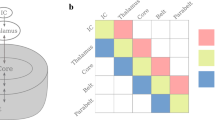Abstract
Spontaneous firing properties of individual auditory cortical neurons are interpreted in terms of local and global order present in functioning brain networks, such as alternating “up” and “down” states. A four-state modulated Markov process is used to model neuronal firings. The system alternates between a bound and an unbound state, both with Poisson-distributed lifetimes. During the unbound state, active and closed states alternate with Poisson-distributed lifetimes. Inside the active state, spikes are generated as a realization of a Poisson process. This combination of processes constitutes a four-state modulated Markov process, determined by five independent parameters. Analytical expressions for the probability density functions (pdfs) that describe the interspike interval (ISI) distribution and autocorrelation function are derived. The pdf for the ISI distribution is shown to be a linear combination of three exponential functions and is expressed through the five system parameters. Through fitting experimental ISI histograms by the theoretical ones, numerical values of the system parameters are obtained for the individual neurons. Both Monte Carlo simulations and goodness-of-fit tests are used to validate the fitting procedure. The values of the estimated system parameters related to the active-closed and bound–unbound processes and their independence on the neurons’ mean firing rate suggest that the underlying quasi-periodic processes reflect properties of the network in which the neurons are embedded. The characteristic times of autocorrelations, determined by the bound–unbound and active-closed processes, are also independent of the neuron’s firing rate. The agreement between experimental and theoretical ISI histograms and autocorrelation functions allows interpretation of the system parameters of the individual neurons in terms of slow and delta waves, and high-frequency oscillations observed in cortical networks. This procedure can identify and track the influence of changing brain states on the single-unit firing patterns in experimental animals.
Similar content being viewed by others
References
Amzica F, Steriade M (1998) Electrophysiological correlates of sleep delta waves. Electroencephalogr Clin Neurophysiol 82:3123–3138
Eggermont JJ (1992) Neural interaction in cat primary auditory cortex. Dependence on recording depth, electrode separation, and age. J Neurophysiol 68:1216–1228
Eggermont JJ (2000) Sound induced correlation of neural activity between and within three auditory cortical areas. J Neurophysiol 83:2708–2722
Eggermont JJ, Smith GM (1995) Separating local from global in neural pair correlograms. Neuro Report 6:2121–2124
Eggermont JJ, Smith GM, Bowman D (1993) Spontaneous burst firing in cat primary auditory cortex: age and depth dependence and its effect on neural interaction measures. J Neurophysiol 69:1292–1313
Ekholm A, Hyvarinen J (1970) A pseudo-Markov model for series of neuronal spike events. Biophys J 10:773–796
Heermann DW (1990) Computer simulation methods in theoretical physics. Springer, Berlin Heidelberg New York
Hoel PG (1971) Introduction to mathematical statistics. Wiley, New York
Kwaadsteniet JW (1982) Statistical analysis and stochastic modeling of neuronal spike-train activity. Math Biosci 60:17–71
Noreña AJ, Tomita M, Eggermont JJ (2003) Neural changes in cat auditory cortex after a transient pure-tone trauma. J Neurophysiol 90:2387–2401
Plenz D, Kitai ST (1996) Generation of high-frequency oscillations in local circuits of rat somatosensory cortex cultures. J Neurophysiol 76:4180–4184
Seamans JK, Nogueira L, Lavin A (2003) Synaptic basis of persistent activity in prefrontal cortex in vivo and organotopic cultures. Cereb Cortex 13:1242–1250
Smith DR, Smith GK (1965) A statistical analysis of the continual activity of single cortical neurons in the cat unanaesthetized isolated forebrain. Biophys J 5:47–74
Steriade M (2001) The intact and sliced brain. The MIT Press, Cambridge, MA
Steriade M, Nunez A, Amzica F (1993) Intracellular analysis of relations between the slow (<1 Hz) neocortical oscillation and other sleep rhythms. J Neurosci 13:3266–3283
Steriade M, Contreras D, Amzica F, Timofeev I (1996) Synchronization of fast (30–40 Hz) spontaneous oscillations in intrathalamic and thalamo-cortical network. J Neurosci 16:2788–2808
Steriade M, Timifeev I, Grenier F (1999) Membrane potential fluctuations of identified neocortical neurons during wake-sleep states in behaving animals. In: Third International Congress of World Federation of Sleep Research Societies, Dresden, Germany, p 84
Stevens CF, Zador AM (1998) Input synchrony and the irregular firing of cortical neurons. Nat Neurosci 1:210–217
Thomas EA (1966) Mathematical model for the clustered firing of single cortical neurons. Br J Math Stat Psychol 19:151–162
Tomita M, Eggermont JJ (2005) Cross-correlation and joint spectro-temporal receptive field properties in auditory cortex. J Neurophysiol 93:378–392
Tuckwell HC (1988) Introduction to theoretical neurobiology. Cambridge UP, Cambridge, UK
Author information
Authors and Affiliations
Corresponding author
Rights and permissions
About this article
Cite this article
Britvina, T., Eggermont, J.J. A Markov model for interspike interval distributions of auditory cortical neurons that do not show periodic firings. Biol Cybern 96, 245–264 (2007). https://doi.org/10.1007/s00422-006-0115-3
Received:
Accepted:
Published:
Issue Date:
DOI: https://doi.org/10.1007/s00422-006-0115-3




